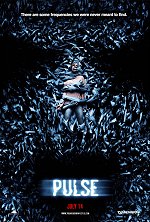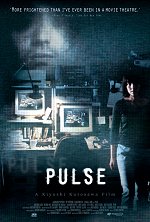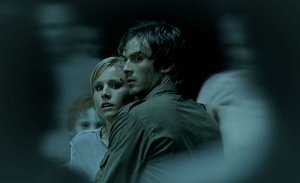 |
|
At The Picture Show
|
August 2006

Lost in translation
True to tradition, 'Pulse' remake waters down its strong Japanese roots
Pulse
Dimension Films
Director: Jim Sonzero
Screenplay: Wes Craven and Ray Wright, based on a 2001 screenplay by Kiyoshi
Kurosawa
Starring: Kristen Bell, Ian Somerhalder, Samm Levine, Rick Gonzalez, Christina
Milian, Ron Rifkin and Jonathan Tucker
Rated PG-13 / 1 hour, 40 minutes
Opened August 11, 2006

 (out of four)
(out of four)
Pulse is a film that begs to be misunderstood. Even the filmmakers
misunderstood it. They inherited Kiyoshi Kurosawa's creepy, apocalyptic thriller
Kairo (Pulse), but somewhere in the translation process, the most interesting
material got lost, while the thriller aspects got kicked up a few notches.
|

Kairo
Magnolia Pictures/Toho Company Ltd.
Director: Kiyoshi Kurosawa
Screenplay: Kiyoshi Kurosawa
Starring: Ryosuke Kawashima, Michi Kudo, Harue Karasawa, Junko Sasano,
Toshio Tabe and Yoshizaki
Rated R / 1 hour, 58 minutes
Available on Netflix and various other rental houses
   
(out of four)
You say horror movie in this country, and you expect one thing. By our
definition, Kairo isn't a horror movie. It's not all that scary (at least not to me), but
it is creepy, chilling, disturbing, depressing, you name it. And it's also infinitely
more effective than its new remake. It's definitely worth renting for those who'd
like to see where Pulse originated -- just don't expect jump scares and gratuitous
gore. This one is a little different -- and that's a good thing.
|
|
|

It's not that Pulse isn't an interesting movie. It
is -- though only intermittently. But it is most interesting when seen in
conjunction with Kairo, as a case study for differing cultural approaches between
American and Japanese cinema. Re-making popular Japanese thrillers is one of
Hollywood's favorite trends, with The Ring, The Grudge and Dark Water among
recent examples. Problem is, the American incarnations are almost always inferior,
and don't really justify their own existence.
I'm not trying to be pretentious -- every country has great movies and bad
movies -- but it's true; the American versions take the same ideas and dumb them
down, throw in some pyrotechnics and MTV editing for good measure and sell
them to teenage horror audiences.
That is true again with Pulse, which does offer some nice visuals, but wraps
them around an ultimately cheap thriller that never explores the thematic depths of
the original.

Japanese teens investigate an increasing number of suicides and disappearances in Kiyoshi Kurosawa's original, Kairo (Pulse).
|
Kairo was a somber, haunting view of the human condition, a disturbing allegory that
examined how the technological bonds that connect us in so many ways actually
isolate us and cut us off from one another. An easy enough point to make, I guess
-- but it was the way the film told its story that made it resonate. Instead of
battering us over the head with its points, Koyoshi Kurosawa (no relation to Akira)
let his visuals and mood do the talking, using the power of suggestion to get
everything across. However abstract and dream-like it was at times, the message
was a clear and potent one. Kairo saw our over-reliance on technology as a sort of
spiritual death; characters lived normal but empty, sad existences, and the result
was a chilling, if a tad depressing, existential nightmare.
Pulse, directed by Jim Sonzero from an awful script co-written by Wes
Craven, prefers the battering method. This version doesn't trust its audience, or any
audience. The storyline is basically the same; the film revolves around a group of
friends -- whose interpersonal relationships have seemingly been reduced to text-messaging and Internet chats -- whose lives start to change when one of their
group mysteriously kills himself after a brief encounter with a ghost at the
university library.
 He is the first to disappear but not the last; for
reasons the film will explain, he has unleashed a disturbing epidemic on the public.
People start disappearing in record numbers. Digital ghosts are involved; they
come through cell phone lines, Internet cables, iPods, etc. They are absorbing
humanity at an alarming rate; both films have a few shots of sudden big-city
desolation that are truly disturbing. In fact, the visuals in Pulse are worth noting;
Sonzero comes up with some genuinely eerie images, which is enough to keep the
story going until it inevitably collapses.
He is the first to disappear but not the last; for
reasons the film will explain, he has unleashed a disturbing epidemic on the public.
People start disappearing in record numbers. Digital ghosts are involved; they
come through cell phone lines, Internet cables, iPods, etc. They are absorbing
humanity at an alarming rate; both films have a few shots of sudden big-city
desolation that are truly disturbing. In fact, the visuals in Pulse are worth noting;
Sonzero comes up with some genuinely eerie images, which is enough to keep the
story going until it inevitably collapses.
The problem, or the biggest problem, is in the writing. This is an absolutely
embarrassing screenplay, from its approach to the plot to the dialogue between the
one-dimensional characters. Craven and co-writer Ray Wright insist on spelling
every single thing out for us as if we're schoolchildren -- or maybe that's just their
demographic. Not only that but, in typical Hollywood thriller form, the film has to
treat the epidemic as just another Villain that needs to be fought, just another
problem that needs to be solved. As far as this version of the film is concerned, the
plot is just about a virus that has gotten out of control and, as one character in the
movie says, "We're going to get some answers!" Sure you are, bud.
 At the center of the story are a few pretty faces
-- Mattie (Kristen Bell of Veronica Mars), Dexter (Ian Somerhalder of Lost) and
the unreasonably gorgeous Christina Milian. The eye candy is nice and all, but
when there are so many interesting things going on under the surface, they're kind
of a distraction. Kairo showed us a decaying culture with precision and care and
intelligence, but in its American form, all that gets lost. It's a strange overall
product -- there are strange echoes of Terminator 2 and 28 Days Later, including a
ridiculously overwrought closing voice-over; there are a few very impressive
sequences, and then one of those terrible scenes where a crazy old man in a diner
starts screaming that the world is going to end. Maybe if the movie spent a little
less time screaming and trying to scare us every five minutes, it would have found
what made the original so unsettling, and so effective.
At the center of the story are a few pretty faces
-- Mattie (Kristen Bell of Veronica Mars), Dexter (Ian Somerhalder of Lost) and
the unreasonably gorgeous Christina Milian. The eye candy is nice and all, but
when there are so many interesting things going on under the surface, they're kind
of a distraction. Kairo showed us a decaying culture with precision and care and
intelligence, but in its American form, all that gets lost. It's a strange overall
product -- there are strange echoes of Terminator 2 and 28 Days Later, including a
ridiculously overwrought closing voice-over; there are a few very impressive
sequences, and then one of those terrible scenes where a crazy old man in a diner
starts screaming that the world is going to end. Maybe if the movie spent a little
less time screaming and trying to scare us every five minutes, it would have found
what made the original so unsettling, and so effective.
Read more by Chris Bellamy